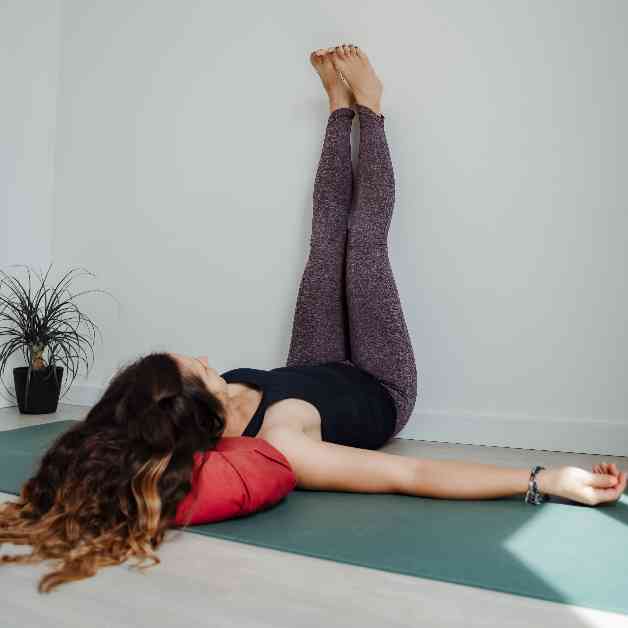Resting your legs up a wall may seem silly at first, but the pose packs a lot of surprising health benefits. There’s something relaxing about this restorative yoga pose – you can close your eyes and just let the wall support the weight of your legs. As a yoga instructor with over 20 years of experience, I often suggest Legs Up the Wall as an alternative to Savasana. Aside from being a relaxing and restorative yoga pose, Legs Up the Wall provides a wide range of physical and mental perks. Read on to learn more about this position, its many benefits, and how to make the most of it.
Known in Sanskrit as Viparita Karani, Legs Up the Wall is technically a type of inversion, meaning your body is flipped from its usual upright position. In yoga, moving your body in a way that’s different from its typical pattern is thought to benefit the mind and body. Legs Up the Wall allows you to reap the benefits of inversions without the strength required for a more difficult pose, such as a handstand or arm balance. Legs Up the Wall also has the following health benefits:
• Helps With Muscle Pain: Our feet, legs, and spine are all weight-bearing structures that work to hold us up. When we de-load these structures by lying down or putting our legs up the wall, we allow our muscles to rest, reducing fatigue and potentially the pain associated with overloading or overworking our tissues.
• Reduces Inflammation: Gravity can cause blood and other fluids to pool in the legs, ankles, and feet. Elevating your legs in Legs Up the Wall pose can help pull any built-up fluid from your legs down toward your pelvis and torso, which is also good for workout recovery and reducing inflammation.
• Increases Flexibility: The wall passively flexes your thighs and knees, lengthening your hamstrings into a stretched position. This can improve flexibility, especially along the backs of the legs.
• Reduces Stress: When you’re stressed out, the nervous system’s fight-or-flight response causes the body to secrete stress hormones such as adrenaline and cortisol. Exercise, meditation, or any restorative posture – including Legs Up the Wall – can actually relieve stress, allowing your muscles to completely relax and giving you an opportunity to focus on your breath. This allows your nervous system to slow down, leaving you with a sense of calmness.
• Relieves Headaches: Studies have found that yoga can relieve tension headaches and even migraines. This is partly because stress is thought to trigger headaches, and, as previously mentioned, this pose can help relieve stress.
• Alleviates Menstrual Cramps: Studies have shown that yoga can significantly reduce the pain of menstrual cramps. Researchers are still trying to pinpoint the physiological reasons why, but a common hypothesis is that yoga increases blood flow to the pelvic area without causing too much stress. Although some yoga traditions advise against doing any inversions during menstruation, it’s not harmful to your body in any way.
• Drains Excess Fluids: Extended time in Legs Up the Wall removes the downward force of gravity, allowing the muscles of your lower body to rest and for any excess fluid to drain.
• Improves Sleep: If your body feels comfortable and relaxed, the parasympathetic “rest and digest” side of your nervous system will start to take over, allowing you to feel calm and ready for rest.
There’s a myth that after having sex, raising your legs and hips can help prevent semen from coming out, giving sperm a better chance of swimming to the egg. However, there’s no scientific evidence that doing this pose will help you get pregnant. Gravity doesn’t affect sperms’ progress toward the egg, so there’s no need to put your legs up against the wall after sex.
You can do this pose anywhere that has a wall – even lying on your bed. To get into the pose, sit with one of your hips as close to the wall as possible. Swing your legs up to the wall as you lower your torso down to the floor. Use your shoulders to shimmy your butt all the way up to the wall. You may choose a Legs Up the Wall variation, bringing your legs into a wide straddle or butterfly position. Otherwise, you can also prop your hips up on a folded blanket, pillow, or yoga bolster, and place a small pillow or towel underneath your head.
If your back or hamstrings are very tight, this pose may be too uncomfortable to feel relaxing. If you aren’t able to do this pose with straight legs against a wall, try propping your lower legs up on something like a chair, couch, step, or stacked pile of blankets or pillows, so your knees are bent but your legs are still supported. Whichever variation of Legs Up the Wall you choose, close your eyes and rest your arms out in T-position, on your heart, or on your belly – anywhere that allows you to completely melt into the floor. Focus on feeling your ribs expand and contract with each complete breath. Stay there for as long as you want, settling into this pose for several minutes if it feels good to you.












